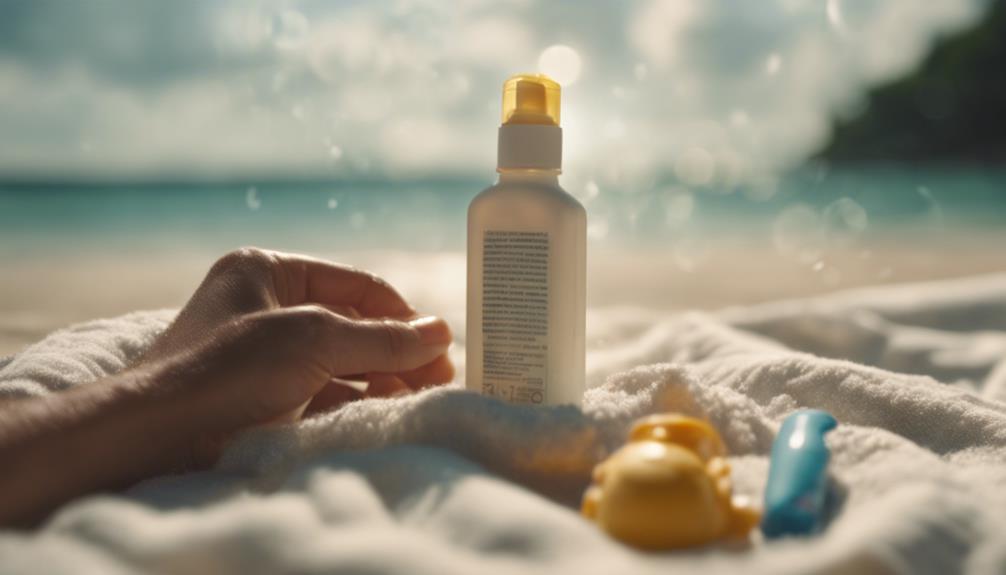You might think skipping sunscreen on a cloudy day is okay, but up to 80% of UV rays can actually penetrate clouds. This means your skin is still at risk for damage, including sunburn and long-term aging. UVA rays, which contribute to skin cancer, are just as harmful when it's overcast. So, applying a broad-spectrum sunscreen daily, even when the sun seems hidden, is essential for keeping your skin healthy. Remember, it's best to reapply every two hours. There's plenty more to explore about sun protection strategies that you won't want to miss!
Key Takeaways
- Up to 80% of UV rays can penetrate clouds, exposing your skin to harmful radiation.
- UVA rays, linked to skin aging and cancer risk, are present even on overcast days.
- Skin can suffer severe sunburns from UVB rays on cloudy days, just like on sunny days.
- Consistent sunscreen application supports long-term skin health and prevents cumulative UV damage.
Importance of Sunscreen on Cloudy Days
Even on cloudy days, neglecting sunscreen can lead to significant UV exposure and long-term skin damage. You might think that the overcast sky provides enough protection, but up to 80% of UV rays can still penetrate through the clouds. That means your skin's at risk even when it feels cool and comfortable outside.
Severe sunburns can happen without direct sunlight, which is why daily application of sunscreen is vital, no matter the weather. Dermatologists emphasize that UVA rays, associated with skin aging and increased skin cancer risk, remain present even when it's cloudy. By skipping sunscreen, you're leaving your skin vulnerable to these harmful UV rays.
Consistent use of sunscreen on cloudy days isn't just about immediate protection; it contributes to your long-term skin health. When you make sunscreen a part of your daily routine, you're actively working to prevent cumulative sun damage that can occur over time.
Understanding UV Ray Penetration

Cloud cover doesn't shield you from UV rays; in fact, they can still sneak through and reach your skin. Up to 80% of UV rays can penetrate clouds, meaning you're still at risk even on overcast days.
UVA rays, which contribute to skin aging and increase cancer risk, don't care about the weather—they can pass through clouds all year round. While UVB rays, responsible for sunburn, might be less intense on cloudy days, they can still cause skin damage if you skip sunscreen.
You might think you're safe in shaded areas or under cloud cover, but UV rays can reflect off surfaces like water, sand, and concrete, further increasing your exposure. This means that even when it seems dreary outside, your skin is still vulnerable to harmful radiation.
Remember, UV rays can reach you indoors too, especially if you're near windows.
To protect your skin, it's essential to apply sunscreen year-round. Don't underestimate the power of UV rays on cloudy days; your skin deserves that extra layer of protection, no matter the weather.
Daily Application Recommendations

Daily sunscreen application is essential, as it protects your skin from harmful UV rays that can penetrate even the thickest clouds. You should apply sunscreen every day, regardless of the weather, to shield your skin from UVA and UVB rays.
Follow these simple recommendations for effective protection:
- Choose a Broad-Spectrum Sunscreen: Look for at least SPF 30 to guard against both UVA and UVB rays.
- Apply Before Sun Exposure: Put on your sunscreen 15-30 minutes before going outside for ideal absorption.
- Don't Forget to Reapply: Reapply every two hours, especially if you're sweating or swimming, to maintain protection.
- Consider All Activities: Even during brief outdoor tasks, apply sunscreen to keep your skin from UVA rays.
Choosing the Right Sunscreen

Selecting the right sunscreen is essential for guaranteeing your skin stays protected from harmful UV rays, even when the sun isn't shining. Look for broad-spectrum protection, which guards against both UVA and UVB rays, as both types can penetrate through clouds. Aim for a sunscreen with at least SPF 30 if you'll be outdoors for extended periods; SPF 15 is usually sufficient for daily use.
If you have sensitive skin, consider mineral sunscreens containing zinc oxide or titanium dioxide. These ingredients act as a physical barrier against UV rays and are often gentler on delicate complexions. Additionally, if you're planning activities that involve water or sweating, opt for a water-resistant formulation to maintain effective protection.
Don't forget to check the expiration date on your sunscreen. Using expired products can leave your skin vulnerable to UV damage, as they may not provide the intended protection.
Best Practices for Application

When it comes to applying sunscreen, timing and technique are key.
You'll want to use enough product for full coverage and reapply regularly to stay protected.
Let's break down the best practices to guarantee you're getting the most out of your sunscreen.
Application Timing Matters
To get the most protection from sunscreen, apply it 15 to 30 minutes before heading outdoors, allowing it to fully absorb into your skin. This application timing is essential because it helps maximize your skin protection against harmful UV rays, which can penetrate even on cloudy days.
Here are some best practices to keep in mind:
- Choose the right sunscreen: Make sure it's broad-spectrum and has an SPF of at least 30 for adequate skin protection.
- Keep it accessible: Store your sunscreen in a spot that's easy to reach, so you're more likely to remember to reapply sunscreen throughout the day.
- Set reminders: Use your phone or a timer to remind you to reapply every two hours or immediately after swimming or sweating.
- Plan for prolonged exposure: If you're outdoors for extended periods, consider bringing a travel-sized sunscreen for convenient reapplication.
Amount for Full Coverage
Using about one ounce of sunscreen—roughly the size of a shot glass—ensures you cover your entire body effectively for ideal UV protection. It's vital to apply this amount to all exposed areas, including often overlooked spots like your ears, neck, and feet. This helps maximize the effectiveness of your sunscreen against harmful UV rays.
| Area of Body | Recommended Amount |
|---|---|
| Face | 1/4 ounce |
| Arms (each) | 1/2 ounce total |
| Legs (each) | 1 ounce total |
| Neck | 1/4 ounce |
| Back | 1/2 ounce |
Applying sunscreen 15 to 30 minutes before sun exposure allows it to absorb properly, giving you the best protection. Remember, don't just apply once and forget! It's important to reapply every two hours, or immediately after swimming or sweating, to maintain ideal protection. For your face, consider using non-comedogenic formulas to avoid clogged pores while ensuring thorough coverage.
Reapply Regularly and Correctly
Regularly reapplying sunscreen is vital for maintaining effective protection against harmful UV rays throughout the day. Even if it's cloudy, up to 80% of UV rays can still reach your skin, so don't skip this important step.
Here are some best practices for application:
- Timing is Key: Apply sunscreen 15 to 30 minutes before sun exposure. This gives it time to absorb and maximize its effectiveness.
- Use Enough: For full-body coverage, aim for about one ounce—the size of a shot glass. This guarantees you're getting adequate sun protection.
- Set a Reminder: Make it a habit to reapply every two hours, or immediately after swimming or sweating. Staying on top of this keeps your skin protected.
- Choose Wisely: Opt for a broad-spectrum sunscreen with at least SPF 30. This helps shield you from both UVA and UVB rays.
Common Misconceptions About SPF

You might think that cloudy days mean you can skip sunscreen, but that's a common misconception.
Many people also assume that a higher SPF means you're protected all day without reapplying, which isn't true.
Let's clear up these misunderstandings about SPF and how to best protect your skin.
Cloud Coverage Misunderstandings
Despite common belief, cloudy days can still expose the skin to harmful UV rays, making sunscreen a must-have regardless of the weather. Many people underestimate the risk of sun damage on overcast days, leading to serious consequences.
Here are some misconceptions you should be aware of:
- Clouds Block UV Rays: Up to 80% of UV rays can penetrate clouds, meaning you're still at risk, even if it looks gloomy outside.
- Only Sunny Days Cause Burns: Sunburns can occur in cloudy weather. Dermatologists report that severe burns can happen without direct sunlight exposure.
- SPF Only Protects Against UVB: While SPF ratings mostly indicate UVB protection, UVA rays are also present on cloudy days and contribute to skin damage.
- Sunscreen's Only for Summer: Daily sunscreen application is essential year-round, regardless of the forecast, to protect against cumulative UV exposure.
SPF Longevity Myths
Many people mistakenly believe that applying a high SPF sunscreen means they're protected all day long without the need for reapplication. In reality, the effectiveness of SPF dramatically declines after about two hours. So, if you're out in the sun, even on a cloudy day, you need to apply sunscreen every two hours to maintain protection against the sun's rays.
Another common myth is that you don't need to reapply if you aren't sweating or swimming. This isn't true; UVB radiation can still penetrate your skin and cause damage, making reapplication necessary. An SPF 30 sunscreen blocks approximately 97% of UVB rays, but that still leaves you exposed to 3%—and that's not something to overlook.
Some folks think that SPF ratings are linear, assuming SPF 50 offers much more protection than SPF 30. In fact, SPF 50 only blocks about 1% more UVB rays.
Additionally, don't forget about broad-spectrum protection, which is essential for shielding against both UVA and UVB rays. It's important to choose a sunscreen that offers thorough defense to truly protect your skin.
High SPF Assumptions
While high SPF sunscreens might seem like a foolproof way to stay protected, they can create misconceptions about how often you really need to apply them. Many people think that a high SPF means they're safe for hours, but that's far from the truth. You still need sunscreen, and here are some high SPF assumptions that can mislead you:
- All-Day Protection: High SPF doesn't mean you're protected all day. You need to reapply sunscreen every two hours, no matter the SPF.
- Duration in the Sun: Higher SPF doesn't prolong your sun exposure safely. It offers only marginally better UVB protection.
- 100% UV Block: No sunscreen can block 100% of UV rays. Even SPF 50 lets in about 2% of UVB rays, so reapplication is key.
- Less Product Needed: Higher SPF doesn't mean you can use less. For full-body coverage, you should apply about one ounce.
Always remember, even on cloudy days, those UV rays are present. Stay diligent with your sunscreen routine!
Protective Measures Beyond Sunscreen

Protecting your skin goes beyond just applying sunscreen; incorporating protective clothing and seeking shade can greatly enhance your defense against harmful UV rays.
Wearing long sleeves and wide-brimmed hats creates a physical barrier, effectively reducing your exposure and helping to prevent sunburn. This is especially important during peak sun hours, from 10 AM to 4 PM, when UV radiation is strongest, even on cloudy days.
Don't underestimate the power of shade. Whenever possible, find shelter under trees, umbrellas, or canopies to further minimize your UV exposure.
Additionally, don't forget about your eyes; wearing sunglasses with UV protection not only safeguards your vision but also helps prevent skin cancer around your eyelids.
Regular skin checks are key, too. By incorporating this practice into your routine, you can identify any unusual changes early, which allows for timely medical intervention and reduces the risk of skin cancer.
Finally, take the time to educate others about these protective measures. Fostering a culture of sun safety in your community can considerably improve everyone's skin health.
Seasonal Skin Care Considerations

As the seasons change, it's vital to adjust your skincare routine to address varying UV exposure and skin hydration needs.
No matter the weather, you must wear sunscreen daily to protect your skin from harmful UV rays that can penetrate clouds. Here are four essential considerations for seasonal skincare:
- Spring: As the sun becomes stronger, increase your SPF to shield against rising UV rays while keeping your skin hydrated.
- Summer: With heightened sun exposure, opt for a broad-spectrum sunscreen. Reapply frequently, especially after swimming or sweating.
- Fall: Shift your moisturizer to combat dryness from cooler air. Continue wearing sunscreen, as UV rays can still affect your skin.
- Winter: Snow can reflect UV rays, intensifying their impact. Keep applying sunscreen daily, even if it's chilly, to prevent skin damage.
Encouraging Sun Safety Awareness

Understanding the importance of sunscreen, even on cloudy days, can greatly enhance your skin's health and safety. Many people underestimate the sun's power on overcast days, but up to 80% of UV rays can still penetrate clouds. This means you still need sunscreen to protect your skin from potential damage.
To help raise awareness, consider sharing key facts with friends and family. Here's a quick reference table to illustrate the need for sunscreen regardless of the weather:
| Situation | UV Exposure | Recommended Action |
|---|---|---|
| Sunny Day | High | Apply broad-spectrum sunscreen |
| Cloudy Day | Moderate to High | Don't skip sunscreen |
| Indoor/Window Light | Low to Moderate | Use sunscreen if near windows |
Frequently Asked Questions
Can I Skip Sunscreen on a Rainy Day?
You can't skip sunscreen on a rainy day. Up to 80% of UV rays can still reach your skin, increasing the risk of damage. Always apply sunscreen before heading outside, regardless of the weather.
Should You Wear Sunscreen Everyday Even if It's Not Sunny?
Yes, you should wear sunscreen every day, even if it's not sunny. UV rays can penetrate clouds, and consistent protection helps prevent skin damage and aging, keeping your skin healthy and radiant. Don't skip it!
Why Are UV Rays Worse on Cloudy Days?
UV rays aren't worse on cloudy days, but they can still penetrate clouds and reach your skin. You might not notice the damage until it's too late, so always apply sunscreen, no matter the weather.
Why Should You Never Skip Sunscreen?
Skipping sunscreen's like inviting a thousand tiny suns to roast your skin! You need daily protection against harmful UV rays, which can lead to premature aging and skin cancer. So, don't ever forget to apply it!
Is it really necessary to use sunscreen on a cloudy day?
Yes, it is essential to use sunscreen on a cloudy day. UV rays can still penetrate through the clouds and cause sunburn on cloudy days. Protecting your skin with sunscreen is crucial to prevent sun damage and reduce the risk of skin cancer. Always apply sunscreen, even on overcast days.
Conclusion
So, don't let those clouds fool you; skipping sunscreen is like leaving an umbrella at home on a rainy day—you're still at risk!
UV rays can sneak through, causing skin damage even when the sun isn't shining.
By applying sunscreen daily, you're building a protective shield against harm.
Remember, sun safety is an ongoing commitment, and every layer of protection counts.
Keep your skin healthy and radiant, no matter the weather!









